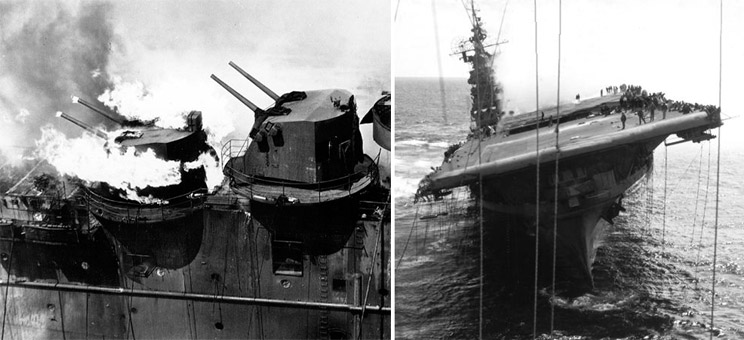I Was There! - Blasted for Hours Off the Coast of Japan
The War Illustrated, Volume 9, No. 209, Page 122, June 22, 1945.
How Japanese bombs struck the 27,000-tons aircraft carrier U.S.S. Franklin on March 19, about 60 miles off the southern coast of Japan, causing one of the most appalling losses of American lives in naval history, is narrated by Pacific War Correspondent Alvin S. McCoy, by arrangement with I.N.S. The carrier's own bombs and a vast quantity of octane gas oil blasted her near to complete destruction.
I was the only war correspondent aboard, a dazed survivor of the holocaust only because I was below decks at breakfast in the unhit area. The rescue of the crippled carrier, towed flaming and smoking from the very shores of Japan, and the saving of more than 800 men fished from the sea by protecting cruisers and destroyers, will be an epic of naval warfare.
Heads bobbed in the water for miles behind the carrier. Men floated on rafts or swam about in the bitterly cold water to seize lifelines from the rescue ships and be hauled aboard. The official loss of life will be announced by the Navy Department in Washington. Unofficial figures at the time showed 949 dead, more than 221 wounded.
Scenes of indescribable horror swept the ship. Men were blown off the flight deck into the sea. Some were burned to cinders in the searing white-hot flash of flame that swept the hangar deck. Others were trapped in the compartments below and suffocated by smoke. Scores were drowned, and others torn by exploding shells and bombs.
Countless deeds of heroism and superb seamanship saved the carrier and about two-thirds of the ship's complement if more than 2,500. The tenacity of the Franklin's skipper, Captain L. E. Gehres, who refused to abandon the ship and accept the aid of protecting ships and planes, virtually snatched the carrier from Japanese waters to be repaired so that she can fight again.
Fire and damage control parties who stuck with the ship performed valiantly. The carrier was all but abandoned, although the “abandon ship” order was never given. An air group and about 1,500 of the crew were sent to the U.S.S. Sante Fé. A skeleton crew of some 690 remained aboard to try to save the ship as it listed nearly twenty degrees. The Franklin's aircraft which were airborne landed safely on other carriers.
3,000-Miles Crawl to Pearl Harbour
Navy officials said the Franklin took more punishment than any other ship has ever taken and yet remained afloat. It was her own highly destructive bombs and rockets that created the havoc. A Japanese plane launched its bombs at the precise moment when it would cause most destruction.
The tragedy took place during the early hours of March 19 when the Franklin was about sixty miles off Japan. Combat patrol planes and fighters had been launched long before dawn. A powerful striking force of planes loaded with all the munitions they could possibly carry began launching about seven o'clock. The sky was dull and overcast. Eight Corsair fighters and eight or nine Hell-diver bombers had already roared off the decks. Other planes were massed aft and loaded with bombs and rockets. It was at this moment that Japanese planes flew in undetected and discharged their bombs.
Reuters correspondent at Pearl Harbour continues the story:
When the Franklin steamed in here – a mass of twisted, blackened steel hardly recognizable as a ship of war – the dead were still being dug out of the tangled ironwork. Having survived five more dive-bombing attacks she had crawled the 3,000-odd miles to Pearl Harbour under her own steam. And, still under her own steam, she left next day for a U.S. mainland naval yard.
 Flames wreathed the gun turrets of the U.S. carrier Franklin after she had been set ablaze (left) by a Japanese dive-bomber when a task force of Vice-Admiral Mark Mitscher's Pacific Fleet struck at Tokyo. Surviving the explosion of 200,000 lb. of her own bombs, shells, bullets and petrol, and suffering over 1,000 casualties, including 832 dead or missing, she listed badly (right) on her 3,000-mile voyage to Pearl Harbour under her own steam. Photos, U.S. Navy.
Flames wreathed the gun turrets of the U.S. carrier Franklin after she had been set ablaze (left) by a Japanese dive-bomber when a task force of Vice-Admiral Mark Mitscher's Pacific Fleet struck at Tokyo. Surviving the explosion of 200,000 lb. of her own bombs, shells, bullets and petrol, and suffering over 1,000 casualties, including 832 dead or missing, she listed badly (right) on her 3,000-mile voyage to Pearl Harbour under her own steam. Photos, U.S. Navy.
Previous and next article from I Was There!
I Was There! - In the Nightmare City of Rangoon Today
The Burmese capital was reoccupied by British forces on May 3, 1945, after nearly three years' occupation by the Japanese. How the once lovely city had been transformed by the enemy to a horror almost
I Was There! - Today Where Our Invasion of Europe Began
Early in June, Stanley Baron, News Chronicle War Correspondent, flew over the Normandy landing-sites where a year ago Britons and Americans gave new glory to the world. Here he describes the desert
Index
Previous article
Now It Can Be Told! - 'Operation Pluto'
One of the Greatest supply stories of the war was released on May 23, 1945, when the existence of an oil pipeline system across the bed of the Channel to the Continent was revealed. This all-British t
Next article
With Our Armies Today
It may seem to many that the task of establishing order in the chaos created by the surrender of the German armies and the liberation of millions of prisoners of war and slave labourers is proceedi



